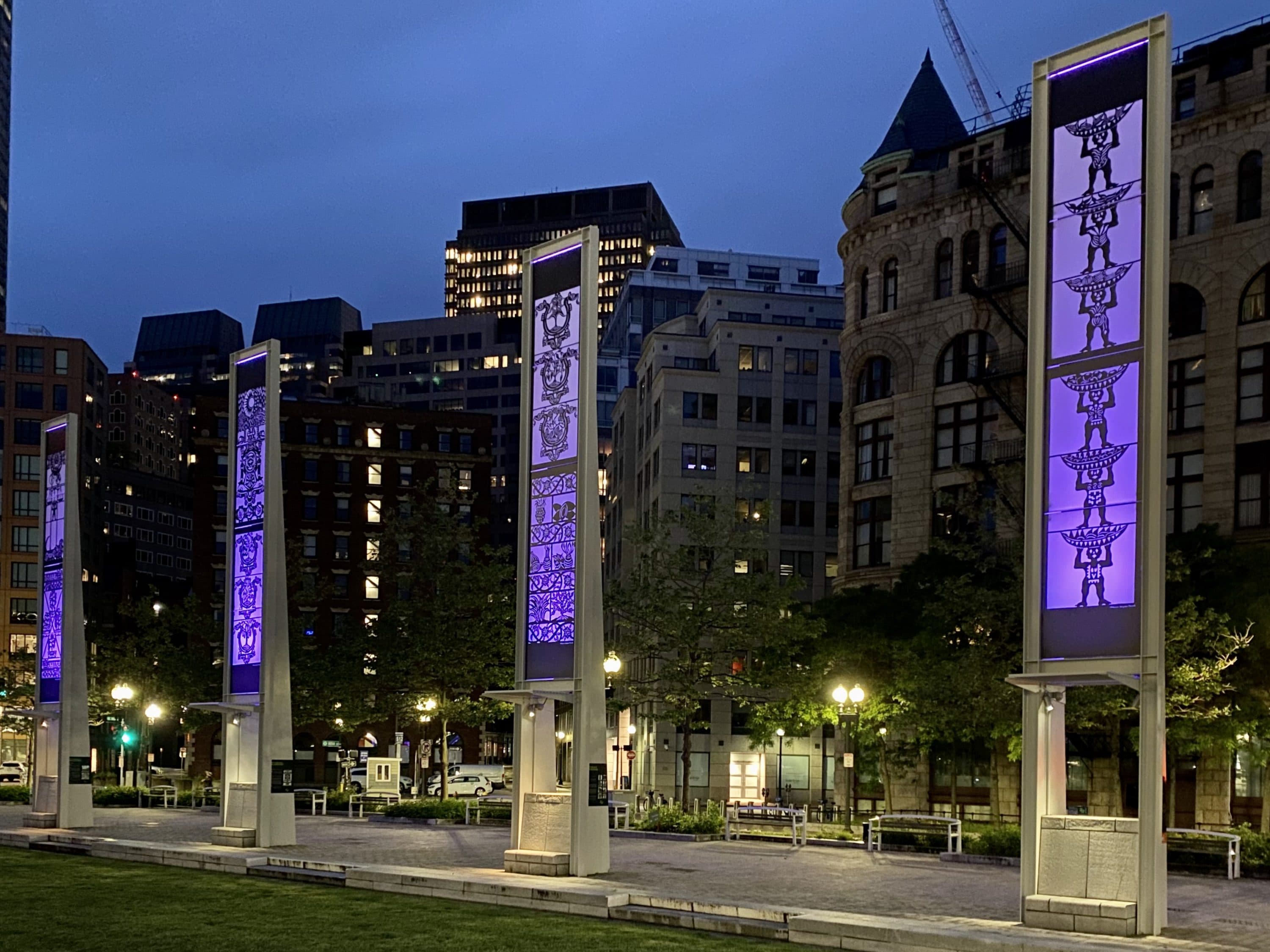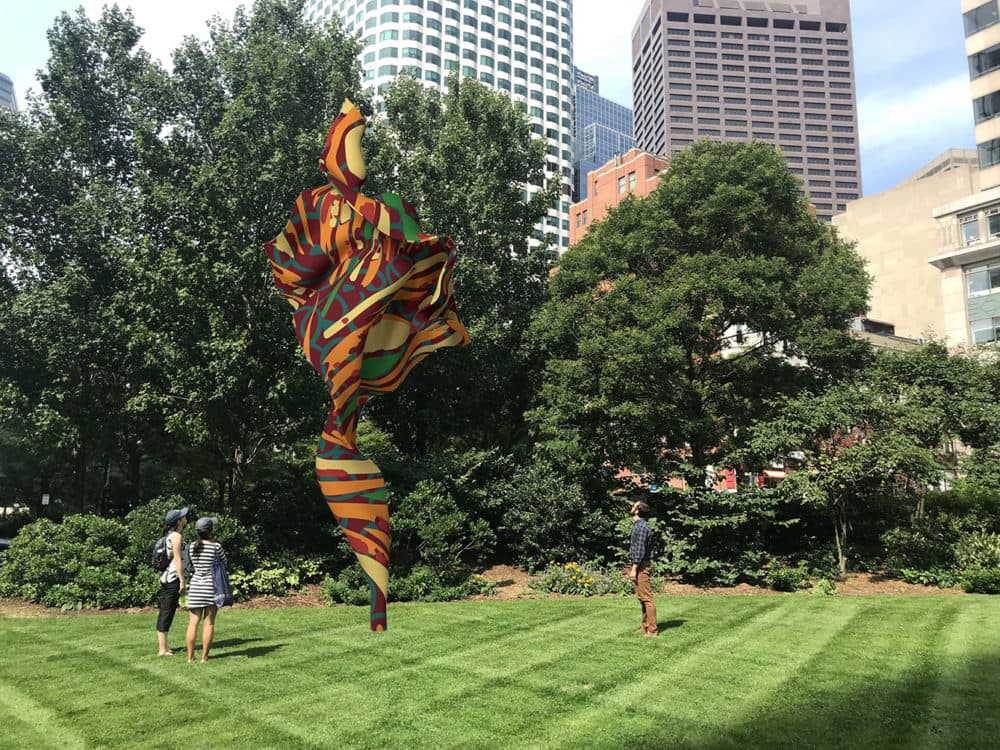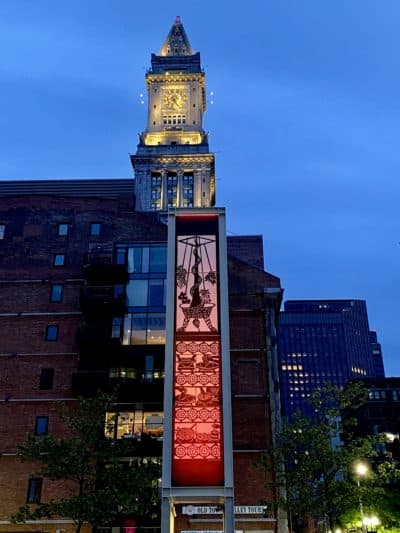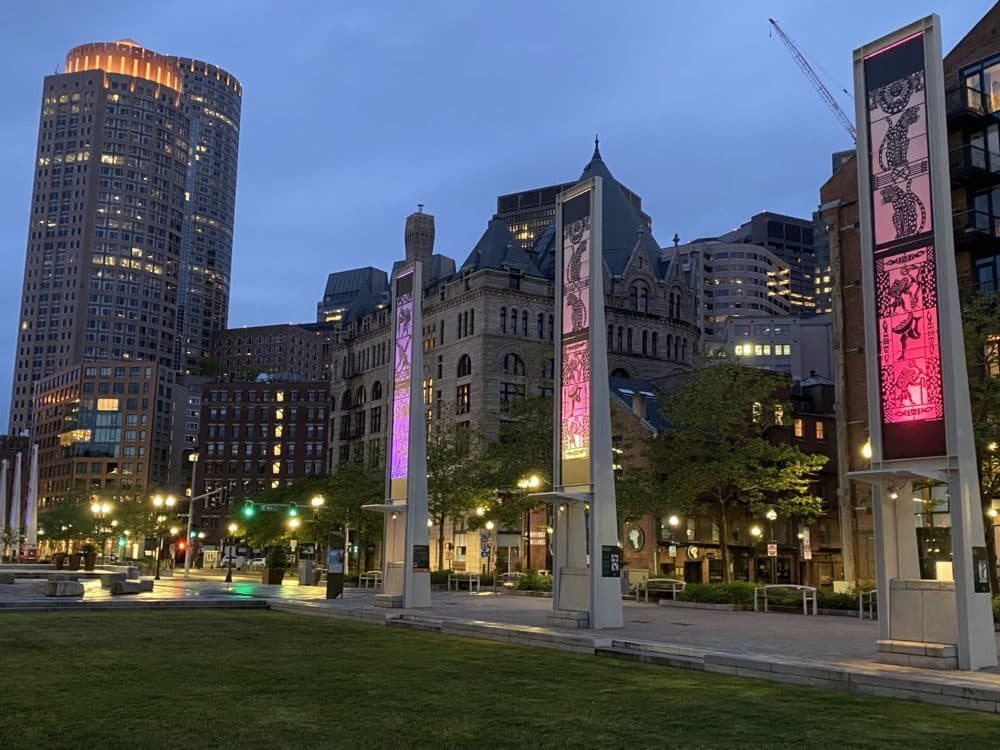Advertisement
New Rose Kennedy Greenway Installations Explore Global Migration And Exchange

The coronavirus pandemic has everyone rethinking how we use outdoor public spaces. Never in our lifetimes has the need for parks, outdoor bars, and open-air culture been so pronounced. With the perfect marriage of nature and art, the Rose Kennedy Greenway offers an urban oasis to Bostonians thirsty for a pandemic-safe cultural experience within city limits.
“If you're tired of sitting in your apartment or your house, or you just need to get out for a day trip, we're here for you,” says Greenway curator Lucas Cowan. The Conservancy, which manages the Rose Kennedy Greenway, has made changes day-to-day operations and care of the park, such as increasing the frequency of cleaning and disinfecting of high-use surfaces and requiring non-essential staff to work remotely, though Greenway Park Rangers are on-site to offer assistance and guidance to visitors.
Food trucks are running on a limited schedule throughout the summer, the wildflowers are in bloom, and on July 7, British-Nigerian artist Yinka Shonibare’s new work “Wind Sculpture (SG) V” will be installed in one of the Greenway’s contemplative gardens, just north of Dewey Square. The 22-foot-tall sculpture features a new twist on Shonibare’s trademark use of colorful batik fabrics.

“I wanted to defy gravity. To do something that actually looks soft, but it's made out of hard materials, like fiberglass and metal,” says Shonibare.
Shonibare’s “Wind Sculptures (SG) I-IX,” which have been installed around the world including in New York City and Washington, D.C., have grown out of his 2010 installation in Trafalgar Square, “Nelson’s Ship in a Bottle.” The wind sculptures are a less literal representation of the ship’s sails, exhibiting the same bold patterns and colors of the wax textiles they seek to imitate. Shonibare uses the fabric, which is often associated with European colonization of West Africa despite originating in Indonesia, often in his work as a metaphor for cultural exchange generally. His wind sculptures allude to the fabric as a way that invites the public to rethink the history and relationship between Africa and Europe.
The colonial criticism inherent in the work is infused with playfulness and joy, inviting everyone to engage with contemporary sculpture in a way he says is often inaccessible to many throughout the world. Despite being one of Britain’s most renowned contemporary artists, anti-elitism is at the heart of his practice and goes beyond artmaking. He’s currently in the process of building an artist residency in Lagos, Nigeria that he hopes will foster the kind of cultural exchange he explores in his own work, as he does his part to unravel the Western exceptionalism and colonialism pervasive in the art world.

“I don't separate my social practice from my visual art practice,” says Shonibare, who views his public sculptures as an invitation for all to engage with art that’s being made today, regardless of education or income level. “It's up to the artist where they choose to locate their work and the kinds of activities they engage in. It's up to artists to be proactive in the community.”
And it’s up to curators to bring this work to the community. Cowan says the Greenway starts planning its summer installations years in advance, but their focus on global migration and exchange couldn’t come at a more prescient time. During the current pandemic, it could be easy to forget that a global refugee crisis wages on as the virus wreaks havoc on the world’s most vulnerable populations. Meanwhile, the Trump administration has cited the economic and health effects of the coronavirus as rationale for instituting near-total bans on some legal avenues for immigration to the United States, while failing to follow the advice of the nation’s top infectious disease experts.
“We're all here on this little planet together, and we have to unify the United States right now,” says Catalina Delgado-Trunk, whose Greenway commission, “Global Connections: Mesoamerican Myths, the Domestication of Nourishment, and its Distribution,” was installed June 5 on eight of The Greenway’s Light Blades situated near the Rings Fountain at Milk Street. Delgado-Trunk is one of the world’s foremost papel picado (paper cutout) artists working today. Her work is a celebration of her indigenous roots as a Mexican woman, honoring both past cultural practices and the connection to the land that is so vital to survival.
The Greenway installation is the first large scale public art exhibition for Delgado-Trunk, whose delicate cutouts were enlarged from photographs and then printed on vinyl. She says at a time when the president of the United States continues to sow hatred and dissent, she wanted to take a different approach by focusing on food and legend, inviting viewers to the table of her cultural heritage.
“The U.S. is in such a critical position, and its leaders have to realize that it has a very rich cultural blanket over it that’s been created number one, by our indigenous people, but also by every single immigrant that comes into this country — whether voluntary or involuntary,” says Delgado-Trunk. Her piece draws from and rearranges pre-Columbian myths to form a new narrative depicting nature’s gifts and humanity’s role in maintaining balance. By focusing mainly on food, she hoped to deepen viewers’ relationships to the rich heterogeneity of culture that thrives on this continent despite the efforts of some.

“We can sit down with a cup of coffee from South America, or a cup of tea from Asia, or a cup of chocolate from Mexico, and we can have a civil conversation over any of these three drinks and not worry about it,” says Delgado-Trunk. “I can't imagine any party being served a nice lasagna and tomato sauce and saying, ‘Oh, I can't have that. Tomatoes come from Mexico, and Mexicans are rapists and drug lords.” An allusion to words spoken by President Donald Trump.
As Bay Staters argue over what to do with outdated statues that no longer reflect our communities, consider visiting the 1.5 mile stretch of green space that extends across a peninsula once called Shawmut, and experience some contemporary art made by people who are creating work that grapples with what it means to be human in our new and ever-evolving world.
